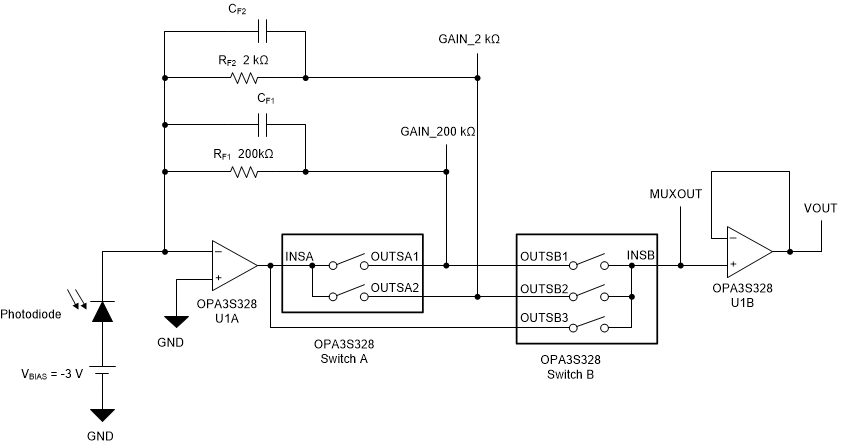SBOA521 June 2021 OPA3S328
1 Introduction
Photodiode sensors produce a current output that changes with incident light, where the typical photocurrent changes orders of magnitude from hundreds of pico-amps to a few milliamps. Transimpedance amplifiers are essential circuits in photodiode acquisition systems to convert photocurrent to voltage that will drive a typical Analog-to-Digital (ADC) converter.
TIAs are required to amplify a photodiode's signal while meeting low-noise, high-resolution, and high-bandwidth constraints. A programmable gain TIA stage allows flexibility to measure the wide range of photodiode current while ensuring the amplifier remains inside its linear range. Programmable gain TIAs are essential in many systems. Applications include photosensor devices such as chemical analysis systems, infrared spectroscopes, data acquisition systems and optical communication applications where the optical power in a fiber can vary widely, and, as a result yield wide current ranges from an optical detector.
The OPA3S328 is a dual precision CMOS operational amplifier (op-amp) with integrated switches optimized for programmable gain transimpedance amplifier applications. The dual op-amp offers low input bias current, DC precision performance, low noise, high bandwidth, providing an optimal choice for transimpedance amplifier applications.
The simplified circuit diagram shown in Figure 1-1 shows a programmable gain TIA circuit implemented with the OPA3S328. The OPA3S328 integrates analog switches useful to select the TIA gains across multiple decades of photodiode current. The second-stage amplifier buffers the programmable gain TIA stage using Kelvin sense connections to eliminate errors due to the switch on-resistance, switch resistance drift, and non-linearity. This document provides a step-by-step example for designing a low noise, high bandwidth, high accuracy programmable TIA to perform optical power measurements using a near infrared (NIR) wavelength photodiode.
 Figure 1-1 Switched Gain Transimpedance Amplifier
Figure 1-1 Switched Gain Transimpedance Amplifier